According to Habermann’s description Lophophora williamsii v. jourdaniana differs from other L. williamsii varieties by having rose-violet perianth, pistil and filaments as well as having small persistent spines on young areoles. 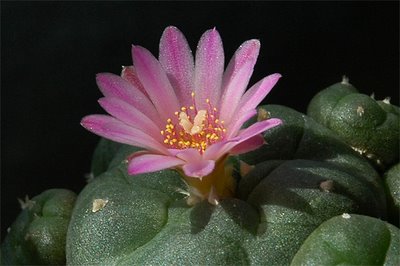
Flowering Lophophora williamsii v. jourdaniana
One of my Lophophora williamsii v. jourdaniana plants flowered today, beautifully illustrating the description (even some spines can be seen faintly in the photos ;-)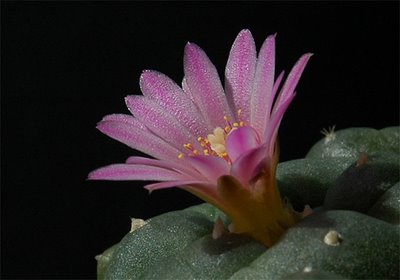
Lophophora williamsii v. jourdaniana flower
Like L. williamsii v. williamsii the jourdaniana variety has thigmotropic stamens, i.e. stamens that when touched fold in around pollinating insects or the style. I wonder if this mechanism is used for actively depositing pollen on pollinators or for avoiding self-pollination (or both)?
L. williamsii v. jourdaniana – thigmotropic stamens
The flowering of this plant coincided with the flowering of my grafted Lophophora williamsii (SB 854; Starr Co, Tx). I decided not to outcross the plants but instead self-pollinate both of them; first of all to keep my SB 854’s “clean”, but also because I want to test the alleged self-incompatibility of the jourdaniana variety.
This Lophophora williamsii v. jourdaniana plant also flowered last year – it was then outcrossed with pollen from a regular L. williamsii and yielded 2 seeds.
Monday, July 31, 2006
Flowering Lophophora williamsii v. jourdaniana
Flowering Lophophora williamsii – II
As mentioned in an earlier post flowering was late this year. My grafted Lophophora williamsii (SB 854; Starr Co, Tx) is now making up for this by showing off its sixth flower this season.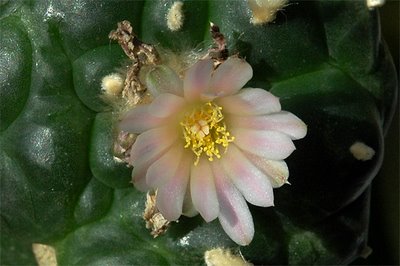
Flowering Lophophora williamsii – 6th flower this season
The three previous flowers unfolded while I was away on vacation – the remains of all the spent flowers are visible beneath the current one.
This flowering coincided with the flowering of a Lophophora williamsii v. jourdaniana. I decided not to outcross the plants but instead self-pollinate both of them; first of all to keep my SB 854’s “clean”, secondly I want to test the alleged self-incompatibility of the jourdaniana variety.
< previous | next >
Friday, July 14, 2006
Flowering Lophophora williamsii
Flowering has been late this year but finally my grafted Lophophora williamsii (SB 854; Starr Co, Tx) decided to come back with a vengeance by setting two flowers simultaneously.

Lophophora williamsii with two flowers
The scar visible in the upper left-hand corner of the photo formed after the epidermis ripped, caused by too vigorous growth.
The flowers are funnelform, pinkish white with a light pink midstripe.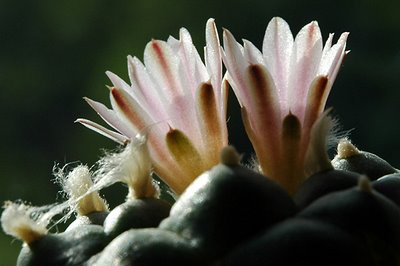
Funnelform flowers reaching for the sun
I self-pollinated the flowers but am wondering if it’s necessary – the anthers are virtually brushing the stigmas, depositing pollen without any help.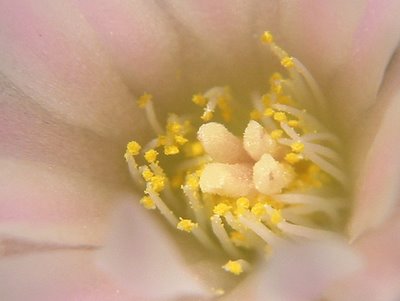
Anthers brushing stigmas
Last growing season I also posted on this plants flowering and fruit setting (use the previous and next links to navigate the posts).
< previous | next >
Thursday, July 06, 2006
Straying Lophophora williamsii flower
The July issue of Kakteen und andere Sukkulenten features an article on weird growth forms in Lophophora and Ariocarpus.
Contrary to common Lophophora behaviour with flowers emerging from the young areoles at the top of the plant, the article shows a specimen flowering from an old areole close to the root neck.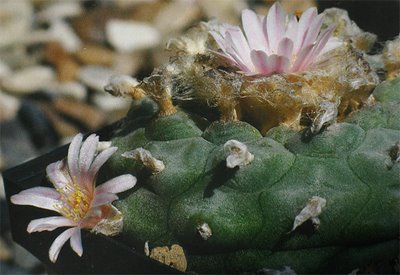
The only information available on the Lophophora specimen is that it was acquired 10 years ago as a L. williamsii var. caespitosa. The plant itself doesn’t seem to tiller, but apparently the areoles are vigorously vital ;-)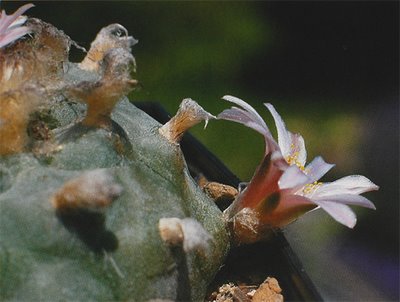
References
Uwe Schriefer (2006), "Sonderbare Auswüchse bei Lophophora und Ariocarpus", Kakteen und andere Sukkulenten 57 (7), 191–192
All Time Most Popular Posts
-
Lophophora williamsii (peyote) populations have diminished in large areas of South Texas where peyoteros harvest the cactus for ceremonial ...
-
On various occasions I've been asked what growing media I'm using for my cactus plants. I don't have a set soil mix recipe as su...
-
Below is a list of retailers/nurseries selling cactus seed and plants. I've only listed vendors I've done business with. If you ar...
-
Most cacti are easily grown from seed - and with a little patience and care they can be grown into beautiful plants. Lophophora williamsi...
-
In last month’s post on the troubled Texan peyoteros I referred to Anderson’s article on the peyote situation in Texas. Given the importanc...
-
Yet another slightly off topic and probably not entirely politically correct post, but I couldn’t help noticing the similarity of my monstr...
-
Flowering stand of San Pedro cacti (Trichocereus pachanoi) To me the main draw of the San Pedro cactus ( Trichocereus pachanoi (syn. Ech...
-
In the June 2008 issue of the Cactus & Co magazine Jaroslav Šnicer, Jaroslav Bohata, and Vojtěch Myšák described a new Lophophora spec...
-
There seems to be an increased focus on the alarming Texas peyote situation. A couple of weeks ago the Houston Press published a mournful, i...
-
I spent two weeks working in Delhi, India during January. I had one weekend off and had planned to spend it in Delhi at my own leisure, but ...


















